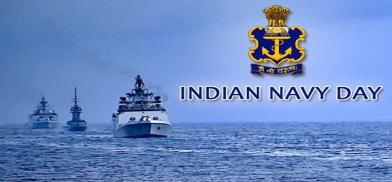India celebrates Navy Day commemorating its operational power and maritime history
Indian Navy celebrates Navy Day on 4 December to commemorate "Operation Trident", the Navy’s lethal attack on Karachi harbour during the 1971 war.

For the first time since independence, the Indian Navy will display its operational prowess and capabilities covering a spectrum of naval operations by the ships and aircraft at the iconic Sindhudurg Fort on the western seaboard of India on Navy Day, December 4, 2023. Hosted by the Navy Chief, Admiral R Hari Kumar, the event will be witnessed from the Tarkarli beach by senior central and state government officials, military dignitaries, diplomats and the local populace. The event aims to celebrate and glorify India's rich maritime history much of which has neither been written about, nor taught, nor talked about.
Maharashtra has over 350 forts, many of which were built by the Marathas during the reign of Chattrapati Shivaji Maharaj. Some of these forts were strategically built on small islands in the sea or extending from the coastland into the Arabian Sea. Some of these sea forts in Maharashtra are Murud-Janjira, Sindhudurg, Vidyadurg, Kolabadurg, Suvarnadurg, Underi and Khanderi.
Built in 1660 by Shivaji Maharaj, the Sindhudurg Fort is an example of India’s rich maritime history and was also found suitable by the Navy to conduct an operational demonstration with many ships.
Mega operational show
Indian Navy celebrates Navy Day on 04 December to commemorate "Operation Trident", the Navy’s lethal attack on Karachi harbour during the 1971 war. A mega operational demonstration in the sea will be conducted to celebrate the valour and courage of the personnel and their resolve to achieve the near impossible under adverse circumstances. The event will also showcase the Indian Navy's state-of-the-art ships and aircraft to the public and online viewers through a live telecast.
The demonstration involves the participation of 20 warships, 40 aircraft - MiG 29K and Navy’s LCA (light combat aircraft)- along with combat beach reconnaissance and assault actions by the Navy’s Marine Commandos. The other major attractions include a performance by the Naval Band, continuity drill and hornpipe dance by the Sea Cadet Corps cadets. The event will culminate with the illumination of ships at anchorage followed by a laser show at the Sindhudurg Fort.
Given India’s vital geo-strategic location with a 7,500 km coastline in the Indian Ocean Region and the threat from two adversarial neighbours, it is amazing how since independence the politico-bureaucratic establishment remained “sea-blind” till India’s fourth war in 1971 and the third waged against it by Pakistan. When then Naval Chief, Admiral S.M. Nanda, popularly known as Charles, got the green signal from then Prime Minister Indira Gandhi for the Indian Navy to participate in the 1971 Indo-Pak War, he was raring to go. At a press conference in Jamnagar, in November 1971, Admiral Nanda was reported to have said, “…. if war comes again, I assure you that we shall carry it right into the enemy's biggest ports, like Karachi. I know this harbour quite well for I started working there. And you have my word that given the opportunity, the Indian Navy will make the world's biggest bonfire of it.” That was a promise which he proved true.
'Killer Squadron' in action
The uniqueness and lethality of the action of the "Killer Squadron" in the 1971 War was reiterated by Admiral Nanda in an interview to Rediff.com at the age of 91 in 2007 when he stated: “On the evening of December 4, we towed these boats out half the way, they dropped their tow lines and raced towards Karachi. We hit Karachi, sank two warships and damaged a third. We did this again on December 8 and sank two more ships. One or two missiles hit the oil tanks near the harbour, which set the entire complex ablaze. Karachi burned for seven days.”
Operation Trident was the first missile attack on Karachi harbour, on the night of 04/05 December 1971 by Indian Naval Ships Kiltan, Katchall, Nipat, Nirghat and Veer. In its maiden missile-boat operation, the Indian Navy destroyed and sank PNS Khyber, a Pakistani destroyer, PNS Muhafiz, a coastal minesweeper, and merchant vessel MV-Venus Challenger. This operation was a watershed in ingenuity and strategic thinking as the Indian Navy used bigger ships to tow these smaller missile boats close to the Pakistani ports - something unthinkable even by those who had built these boats.
Dealing a deathly blow to the Pakistan Navy and crippling it for years to come, Operation Trident is considered to be one of the most successful operations in modern naval history, with no casualties being sustained by the Indian forces. In another Operation Python, the Indian Navy launched another daring attack on the night of 8-9 December, when INS Vinash, along with two frigates, fired four Styx missiles, sinking the Pakistan Naval Fleet Tanker, PNS Dacca and causing substantial damage to Keamari Oil Storage Facility at Karachi. Again, there were no damages reported to Indian forces. The squadron was given the title of ‘Killers’ and the Indian Navy instituted 4 December as Navy Day.
India's seafaring history
India’s history of seafaring, albeit untaught, dates back to five thousand years at least. The world’s first tidal dock is believed to have been built at Lothal, near the present-day Mangrol harbour on the Gujarat coast, around 2300 BCE during the Indus Valley civilization.
The Rig Veda, written around 1700 BCE, credits Varuna with knowledge of the ocean routes and describes naval expeditions with reference to Plava, the side wings of a vessel which give stability to the ship sailing in stormy waters, and Matsya yantra, a compass used for navigation in the 4th and 5th century AD. The earliest known reference of an organization devoted to ships and sailing in ancient India is from the Mauryan Empire, 4th century BCE.
Emperor Chandragupta Maurya’s strategic adviser Kautilya’s Arthashastra has a chapter on the state department of waterways under navadhyaksha, Sanskrit for Superintendent of ships (Chapter XXVIII in Book II, “The Duties of Government Superintendents” of the Arthasástra of Kautilya). The term, navadvipantaragamanam, Sanskrit for sailing to other lands by ships, is mentioned in this book in addition to appearing in the Buddhist text, Baudhayana Dharmasastra using the term, amudrasamyanam (Sanskrit for sea voyage). Sea lanes between India and littoral countries in the Indian Ocean theatre were the trade routes for many centuries. It was through these that Indian culture also spread widely and influenced.
While the Maurya, Satavahana, Chola, Vijayanagara, Kalinga and Maratha empires had powerful navies, it was the Cholas who did very well in foreign trade and maritime activity, extending their influence overseas to China and Southeast Asia.
It was under the reigns of Raja Raja Chola and his son, Rajendra Chola (between 985 and and1044), that the Cholas launched naval campaigns, subdued many kingdoms and expanded their empire to Southeast Asia which included Myanmar, Malaya (now Malaysia), Sumatra (an Indonesia island) etc. and even sent ambassadors to countries as far off as China.
“Jalameva yasya, Balameva yasya” is a saying in Sanskrit, which means "The one who controls the sea is all-powerful." What Indians did centuries ago, Britain did with the power of its navy, till World War II. And in a couple of centuries of ruling and looting India, it also suppressed much of its history.
)The author, a commentator and former spokesperson, Defence Ministry and Indian Army, can be contacted at wordsword02@gmail.com)
was good. I don't know who you are but certainly you're going to a famous blogger if you are not already ;) Cheers!
what I submitted and say, I'm thoroughly enjoying your
blog. I as well am an aspiring blog blogger but I'm still new to the whole thing.
Do you have any recommendations for newbie blog writers? I'd definitely appreciate it.










Post a Comment